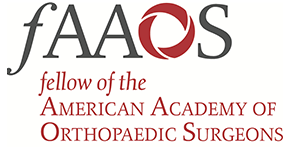FAQs

The purpose of this section is to answer some common Frequently Asked Questions. Additional information is available in site links when applicable.
Arthritis is a general term used to describe the loss of cartilage from joint surfaces, or the ends of bones that move against each other. When the cartilage loss is significant enough to be visible on an xray and causes joint pain, we say that the joint has arthritis. Cartilage can be worn away through wear and tear, and this etiology is termed degenerative arthritis or osteoarthritis. Cartilage can also deteriorate due to inflammatory conditions (such as rheumatoid arthritis), trauma, or infection. Arthritis of the hip can cause groin and hip pain with stiffness and limitations on stairs or with shoes and socks. Knee arthritis can cause pain and swelling and stiffness, and affect mobility and even cause deformity of the leg.
A joint replacement is a surgical procedure that removes the damaged bearing surfaces of a joint and resurfaces it with artificial materials. It is a misnomer, as the surgery is more of a resurfacing of the knee, rather than a replacement of the bones. The implants that resurface the joint ends are attached to the bones either with bone cement or via biologic bone growth into porous surfaces on the implants themselves. Joint replacement is widely successful and is most common for the hip and knee, but also available for the shoulder, elbow and ankle joints. Hip replacement and knee replacement are two of the most successful procedures in modern medicine. For detailed information on hip or knee replacement, download our hip brochure or knee brochure.
Joint replacements relieve pain, reduce stiffness and restore function. An arthritic joint is painful because the nerve endings in the bones on either side of the joint that are normally covered with cartilage have become exposed due to cartilage loss. These joints are often stiff, due to the formation of bone spurs, extra fluid production by the lining of the joint, and contraction of the joint capsule in the presence of prior injury. A joint replacement relieves pain because it eliminates the bone against bone contact in the damaged joint, so the nerve endings are no longer irritated. Stiffness is reduced through removal of bone spurs and the reduction in the production of synovial fluid that comes with a healthier joint. Relief from pain and stiffness means that our patients can return to more active lifestyles. Visit the Testimonials or Stories pages to share in past and current patients’ experiences.
An evaluation by a physician is useful if you have hip or knee pain, joint stiffness, limitations in activities, trouble sleeping, or decreasing function. When simple measures such as the use of anti-inflammatory medications or injections are no longer effective, it is time to give us a call. We often recommend that our patients make a list of the things they cannot do as well as they would like, and when that list is too long to live with, surgery may well be the answer. A physical examination and xray will allow us to discuss with you whether joint replacement is next appropriate treatment option. Visit the What to Expect at a Consultation page to learn more.
For patients with arthritis isolated to a single compartment of the knee, partial knee replacement may be a surgical option. While total knee replacement has excellent outcomes, the benefits of partial over total knee replacement include a less invasive operation, preservation of bone and all ligaments, less blood loss, potentially better knee range of motion, faster recovery, and a more normal feeling knee. Early detection is important with a thorough physical exam and radiographic studies to determine if partial knee replacement is appropriate. Dr. Sah performs some of the highest volume of partial knee replacements in the state, teaches other surgeons the technique, and serves as national lead investigator of one of the leading prostheses available today.
The Institute for Joint Restoration is a unique facility capable of providing comprehensive joint replacement care in a state-of-the art building with highly specialized staff. Dr. Sah and his team specialize in primary hip and knee surgery, along with complex revision surgery. This is all that we do, and our outcomes are unmatched. The IJR was the top rated joint replacement program in California by Healthgrades recently and has continually received the highest marks for nearly two decades. Consumer Report has also rated the program as one of the best and safest in California. If you live outside the area, you will be one of the 85% of our patients who travel here to participate in our program.
Furthermore, Dr. Sah and his team have the unique ability to provide the most compassionate joint replacement care possible. Annual recipients of “Best of Fremont” and “Most Compassionate” and “America’s Top 1%” doctor awards, the team emphasizes always placing the patients needs first. Our commitment to our patients is reflected in their outstanding outcomes and their personal experiences (read more at Testimonials).
Dr. Sah also has extensive experience teaching other surgeons, presenting research, and lecturing at national meetings. Being active in national leadership committees and collaborating with peers across the country allows Dr. Sah to bring the most up to date and proven treatments to his own patients.
Over 1500 joint replacements are performed yearly at the Institute for Joint Restoration. Many studies have shown that improved outcomes with reduced complications are achieved when joint replacement is done by high volume surgeons, at high volume hospitals. In contrast, the majority of joint replacements performed in the US are performed by surgeons who replace fewer than 20 to 30 joints per year.
Primary joint replacement, as opposed to revision joint replacement, generally takes less than an hour in the hands of a specialist. The steps involved in both hip replacement and knee replacement are consistent and easily streamlined in a high volume setting. Speed is important, since infection rates are directly linked to the amount of time the skin is open. Accuracy is even more important, however. Because of the specific focus of our program and our tremendous experience, we have been able to combine accuracy and a streamlined approach to surgery, producing speed as a by-product.
Most total joint surgeries take place in the modern, efficient operating rooms at Washington Hospital in Fremont, California. The Institute for Joint Restoration is housed there, in the Center for Joint Replacement building, a hospital within the hospital. Select total and partial knee replacements may be performed at the Washington Outpatient Surgery Center, primarily for patients expecting to be discharged the same day. As co-Director of the IJR program at the main hospital, and as Director of the Outpatient Joint Replacement program at the Surgery center, same-day or next-day joint surgeries can be safely performed at either location.
Yes and no. We do not teach medical students or residents at our facility, although many orthopaedic residents/fellows hear our presentations at national meetings and read our research studies. Research and teaching is a valuable part of what we do, but we believe that until resident physicians master the anatomy and surgical techniques through performing hundreds of operations, they should be operating through larger incisions than we employ and require constant supervision. We do, however, participate in the teaching of practicing orthopaedic surgeons who want to refine their techniques or learn more streamlined methods for joint replacement care. We regularly host site visits and have the operating rooms equipped with video cameras and monitors for teaching purposes. Visiting surgeons are there to observe only and their presence in the operating room requires patient consent. Many of our patients take advantage of our video system and observe their own surgery.
Yes we do. Our PAs, Meena and Stephanie, are highly skilled and experienced orthopaedic specialists. They know more about joint replacement surgery than most orthopaedic residents and many attending physicians. They participate in the preoperative and postoperative care of our patients, assist in surgery, and help our patients have their questions answered more quickly and efficiently. Unlike resident physicians, who rotate to new hospitals and new attending physicians every few months, our PAs work side-by-side with Dr. Sah at all times.
After the operation is complete, our patients generally spend 2 – 3 hours in the recovery room. Patients are then transported to a private room in the Center for Joint Replacement (CJR) building, where care is transferred to the staff of the Institute for Joint Restoration. We believe that separating our patients away from the ill patients in the main hospital is important for infection control. The private rooms on the unit add privacy that our patients have come to appreciate.
Hip and knee patients will be walking with our Physical Therapists the day of surgery and generally require only a single overnight hospital stay. Some patients feel well enough to go home the very same day as surgery.
All surgery poses certain risks. Fortunately, the chance of a significant complication with joint replacement is very low. The risks specific to hip and knee replacement surgery include bone fracture during the preparation or implant insertion process, or infection. Thankfully, these complications are very rare. Blood clots in the deep veins of the legs can also develop after surgery, although this is also very unusual with early mobilization and temporary blood thinners. Other risks that can occur with any type of surgery include damage to nerves and blood vessels. The Institute for Joint Restoration is unique as a separate building exclusively used for joint replacement, private rooms, and specialized care. These features minimize risks after joint replacement to some of the lowest in the state. Allergy to the implant materials is exceptionally rare, described on a case report basis. For a complete discussion regarding the complication rates after joint replacement surgery, please download our hip brochure or knee brochure.
Over 95% of patients are discharged directly home from the Institute. Homeward-bound patients are safe, comfortable and walking. Availability of family or friends to help with food preparation or household chores is beneficial for the first few days after discharge, especially. In the infrequent situations where safety is an issue or help is not available, our case manager specializes in facilitating brief rehab stays. The literature shows that patients who go home after surgery have better outcomes and fewer complications than those who go to a rehab facility.
Yes. Many of our patients are discharged using a cane for assistance and some need a walker. For hip replacement patients, other special equipment is helpful for dressing and reaching items on the floor. Raised toilet seats are a nice convenience. Knee replacement patients may find cooling units can be very helpful to reduce knee swelling. All equipment will be provided by the Institute therapy staff, and most of it is covered by insurance.
Patients return to clinic for the first postoperative visit about 2 weeks after surgery. Xrays are taken at this time and an evaluation performed. A second postoperative visit is scheduled for 4 weeks later, either in person or by phone. Subsequent visits often occur three or 6 months after surgery, as needed. Patients then return on an annual schedule.
Yes. The therapy begins in the hospital and will continue at home. The Institute physical therapists will highlight the specific exercises to focus on from the education binder. A physical therapist visits our patients at home to ensure optimal continuity. Our knee patients generally need formal physical therapy in an outpatient clinic near their home as well, which we help facilitate. In some ways, what our patients gain from their successful surgeries is heavily influenced by what they put in, especially with regard to preoperative physical preparation and consistent, appropriate postoperative exercise.
Most patients are able to walk without assistive devices by 1-2 weeks, which means that balance has been restored and hands are freed to be useful. At the 6-week point, patients are able to resume regular activities, including golf or doubles tennis. Skiing can be resumed about 2-3 months after surgery. View the patient Videos page for examples of patient activity after surgery.
In general, the need for revision hip or knee replacement occurs at a rate of less than 1% per year. Implants can fail due to liner wear or component loosening from the bone. Replacements that are done well, using modern materials, should last over 20 years in most patients, if not a lifetime. The implant failure rate depends on patient activity, age, weight, and patient characteristics (such as bone quality, muscle and ligament strength, and others). The plastic liners are highly durable, but if wear occurs, they can be removed and changed without disturbing the metal components. If necessary, one or both sides of a joint replacement can be replaced.
We specialize in the treatment of hip and knee disorders. While we do not treat these other body parts, more information may be available in the handout section.
Medicare pays for joint replacement surgery and currently does not ration care. We are able to work with most private insurers and we do our best to provide care to those who choose our program. Due to the variability of insurance plans, it is difficult to predict what or how much will be covered by individual carriers. It may be useful to contact your insurance provider or your employer’s insurance liaison with questions. Our billing specialist, Laurie (This email address is being protected from spambots. You need JavaScript enabled to view it.), is happy to help you determine any possible out-of-pocket costs.





